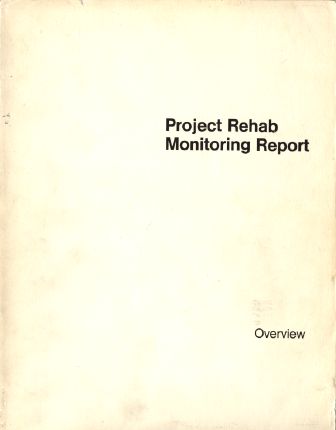


Books
Articles
Other Publications
Practice
Biography
Contact
Project Rehab Monitoring Report Overview
Report to: U.S. Department of Housing and Urban Development
May 1971
Arthur D. Little, Inc.
Conclusions and Recommendations
Project Rehab was initiated in July 1969 as a special program within the U.S. Department of Housing and Urban Development. Its purpose was to encourage large-scale rehabilitation as an approach to providing standard housing for low to moderate-income residents of central cities, as well as for meeting a portion of the nation's housing-production goals for the decade ending in 1978. It was intended that the program would be primarily an FHA undertaking. A special staff within the Washington headquarters was set up to provide guidance and direction to field offices and sponsors. A Project Rehab team, headed by an Assistant Commissioner within FHA and including representatives from the major HUD divisions, was to administer the program with policy direction from the HUD Assistant Secretaries. The program was to have no special funding, but to rely on imaginative use of existing funds and to achieve maximum impact by coordinating a variety of HUD and other Federal programs. Subsidy funds were to be set aside to underwrite the projects.
In June 1970, HUD contracted with Arthur D. Little, Inc., with Roy Littlejohn and Associates, Boise-Cascade Urban Development, and the National Non-Profit Housing Center as subcontractors, to conduct a research and monitoring program related to Project Rehab. The consultant team was to undertake two major tasks: (1) to develop a "state of the art" manual together with appropriate training materials on how to carry out large-scale rehabilitation of absentee-owned properties, and (2) to monitor the Project Rehab effort in selected cities to provide data and experience reports on the major successes and failures and make recommendations on possible improvements in HUD's rehab program.
This report presents, in overview, the results of the monitoring as of mid-May 1971. Specifically, it is an evaluation and comparison of the Project Rehab experience in 14 cities \0x2013 Pittsburgh, New York, Philadelphia, Indianapolis, Cincinnati, Detroit, El Paso, Hartford, Memphis, Seattle, Los Angeles, Buffalo, Baltimore, and Cleveland. The reports on each of the cities, as well as the training materials resulting from the first task, have been presented separately. The city reports and this overview report were intended to record the Project Rehab experience for one year. It is not intended that the monitoring process provide day-to-day information and data to HUD or the city participants.